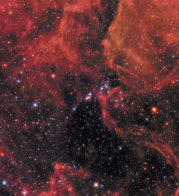
Image credit: MicroBooNE.
MicroBooNE, an experiment designed to measure neutrinos and antineutrinos generated by Fermilab’s Booster accelerator (CERN Courier September 2014 p8), has recorded its first neutrino events. MicroBooNE is the first of three neutrino detectors of the lab’s new short-baseline neutrino (SBN) programme, recommended by the 2014 report of the US Particle Physics Project Prioritization Panel (P5). The ICARUS detector (being refurbished at CERN) as far detector, MicroBooNE as intermediate detector and SBND as near detector will compose the SBN project.
Designed to search for sterile neutrinos and other new physics phenomena in low-energy neutrino oscillations, the SBN programme aims to confirm or refute the hints of a fourth type of neutrino first reported by the LSND collaboration at Los Alamos National Laboratory, and resolve the origin of a mysterious low-energy excess of particle events seen by the MiniBooNE experiment, which used the same short-baseline neutrino beam line at Fermilab.
MicroBooNE uses a 10.4 m-long liquid-argon time-projection chamber (TPC) filled with 170 tonnes of liquid argon. The TPC probes neutrino oscillations by reconstructing particle tracks as finely detailed 3D images. When a neutrino hits the nucleus of an argon atom, its collision creates a spray of subatomic particles. Tracking and identifying those particles allows scientists to reveal the type and properties of the neutrino that produced them.

Image credit: Fermilab.
The MicroBooNE time-projection chamber is the largest ever built in the US and is equipped with 8256 delicate gold-plated wires. The three layers of wires capture pictures of particle interactions at different points in space and time. The superb resolution of the time-projection chamber will allow scientists to check whether the excess of MiniBooNE events – recorded with a Cherenkov detector filled with mineral oil – is due to photons or electrons.
MicroBooNE will collect data for several years, and computers will sift through thousands of neutrino interactions recorded every day. It will be the first liquid-argon detector to measure neutrino interactions from a neutrino beam with particle energies of less than 800 MeV.
Construction is under way for the two buildings that will house the other detectors of the SBN programme: the new 260 tonne Short-Baseline Near Detector (110 m from the neutrino production target) and the 760 tonne ICARUS detector (600 m) that took data at the Gran Sasso National Laboratory in Italy from 2009 to 2012. Like MicroBooNE (470 m from the target), they are both liquid-argon TPCs.
The MicroBooNE collaboration comprises 138 scientists from 28 institutions, while more than 200 scientists from 45 institutions are collaborating on the SBN programme. The experience and knowledge they will gain is relevant for the forthcoming Deep Underground Neutrino Experiment (DUNE), which will use four 10,000 tonne liquid-argon TPCs to examine neutrino oscillations over a much longer distance (1300 km) and a much higher and broader energy range (0.5–10 GeV).





